Maintenance intervals
Daily Maintenance Procedures
- - Inlet duct - check.
- - Coolant level - check.
- - Crankcase breather tube - check.
- - Drive belts - check.
- - Cooling fan - check.
- - Water separator for fuel - drain sediment.
- - Engine oil level - check.
- - Fluid level for diesel exhaust systems - check.
Maintenance procedures every 10,000 km [6,000 miles], 250 hours or 3 months
- - Hydraulic pump drive - check.
- - Generator - check.
- - Air conditioning compressor - check.
- - Air filter resistance - check.
- - Aftercooler - check.
Maintenance procedures every 20,000 km [12,500 miles], 500 hours or 6 months
- - Oil and oil filter - change.
- - Fuel filter - replace.
- - Cooling system - check.
- - Radiator cap - check.
Maintenance procedures every 40,000 km [25,000 miles], 1000 hours or 1 year
- - Fan belt tensioner - check.
- - Belt driven fan hub - check.
Maintenance procedures every 80,000 km [50,000 miles], 2,000 hours or 2 years
- - Cooling system - flush.
- - Radiator hoses - check.
- - Crankshaft pulley/vibration damper - check.
Maintenance procedures every 160,000 km [100,000 miles], 4,000 hours or 4 years
- - Valve mechanism - adjust.
- - Fluid dosing unit for diesel exhaust systems - replace.
Choice of engine oil
The choice of engine oil is based on the temperature range of operation of the car and the instructions of the car manufacturer.
Please note that the selected oil with the appropriate viscosity (according to SAE) also meets the quality requirements (API, ACEA or JACO).
The choice of engine oil viscosity is based on the recommendations of the vehicle manufacturer and the temperature range of the vehicle.
Cummins recommends:
- - at operating temperatures above 15°C, use high-quality all-weather engine oil SAE 15W-40.
For operation at lower temperatures, lower engine oils with a viscosity according to SAE 10W-30 and quality according to CES 20078 (API CI-4) or CES 20081 (API CJ-4) can be used.
According to Cummins and Mack testing, the above engine oils can be used over a wider temperature range than 10W-30 oil that meets the previous API requirements.
Because these oils are designed to operate in thinner oil film conditions than 15W-40 oils, high quality Fleetguard filters should be used at temperatures above 20°C, use engine oils such as Valvoline Premium Blue, Valvoline Premium Blue Extreme Life or equivalent , as well as Fleetguard oil filters or equivalent.
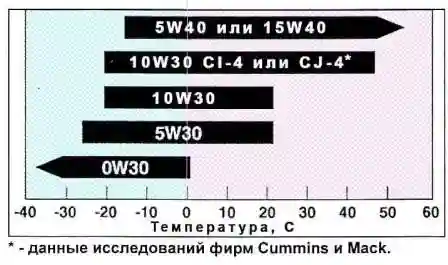
Use CES, API, ACEA, etc. grade oil. not lower than specified by the vehicle manufacturer
Cummins engine oil grade selection
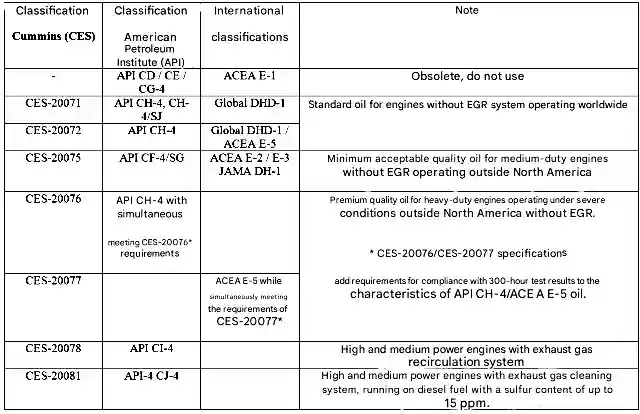
Caution: The use of CES-20081 oil in off-road vehicles running on high sulfur fuels can cause serious damage to the fuel system and engine if engine oil change intervals are not strictly followed.
It is not recommended to mix oils made on different bases (for example, synthetic with mineral).
Mixing may result in precipitation of additives.
It is undesirable to mix oils from different manufacturers, since each manufacturer uses its own package of additives that can react and lead to a deterioration in the properties of the oil.
It is not recommended to add any additives to engine oil, as this can damage the mechanical part of the engine.
When buying engine oil, you should also check the expiration date of the oil.
The shelf life of oil is regulated, and as a rule, the date of packaging of the oil is indicated on the container;
Checking the engine oil level
Before carrying out this test, park the vehicle on a level and level surface.
Check with the engine off.
If the engine is running, then stop it and wait a while before starting the test.
Put the car on a level mountain isontal surface.
After turning off the engine, wait a few minutes for the oil to drain into the crankcase.
Remove the dipstick and wipe the oil off the dipstick with a clean cloth.
Insert the dipstick into the dipstick guide as far as it will go.
Remove the dipstick slowly and check that the oil level is within the indicated range.
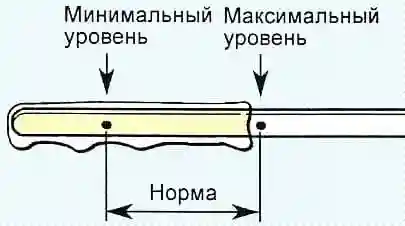
If the oil level is below the minimum, add the recommended engine oil.
Note: the volume of oil added to the crankcase from the low level mark to the upper level mark is 1 liter.
Attention: filling engine oil above the maximum level will adversely affect engine performance.
Start the engine, idle and then shut it off.
Wait a while and check the oil level again to make sure the level is within the specified range.
It is necessary to make sure that the oil has sufficient viscosity, and also check the absence of coolant impurities, fuel impurities and the degree of contamination of the oil.
Changing engine oil and filter
When changing the engine oil, it is recommended to change the oil filter as well.
The frequency of oil change depends on its quality and operating conditions.
When using the recommended oil grade (CES-20072, CES-20077, CES-20078), the oil and filter must be changed every 20,000 km.
When using an oil of a class below the recommended one - once every 10,000 km.
Put the vehicle on a level surface.
Warm up the engine to 60°C and turn it off.
Remove the oil filler cap and unscrew the oil pan drain plug.

Drain the oil into a suitable container.
Warning: be careful as the oil is hot.
Remove the oil filter.
a) Remove the dirt around the oil filter.
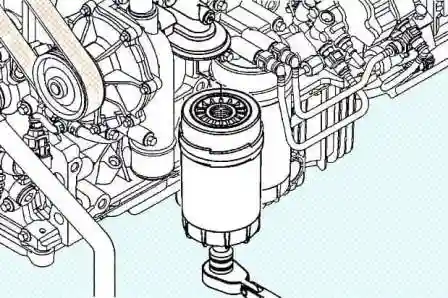
b) Unscrew the oil filter using a puller or wrench.
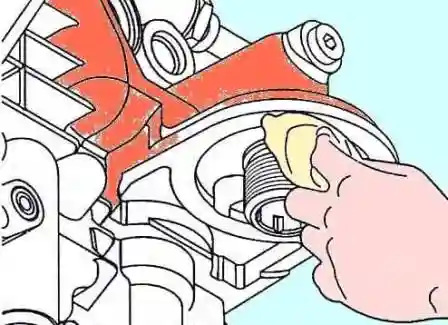
c) Clean the mating surface for the oil filter.
Install the oil filter.

- a) Lightly oil the O-ring.
- b) Fill the filter with clean oil.
Warning: lack of lubrication due to the delay caused by filling the filter with oil can damage the engine
Note: Do not allow foreign particles to enter the filter.
When using oil from a canister sealed with a metal or plastic film, carefully peel off the film.
If you pierce it with a knife or a sharp object, foreign particles may enter the canister.
- c) Screw the filter onto the seat by hand until the gasket contacts the mating surface.
- d) Using a puller, further tighten the filter by 3/4 - 1 turn.
Install the drain plug with a new O-ring.

Tightening torque 20 Nm
Fill with new engine oil.
Filling capacity:
- - in the oil pan about 10.5 l
- - total capacity 13.1 l
Note: The amount of engine oil can vary significantly depending on engine modification.
Start the engine. Check for leaks.
Stop the engine, wait about 5 minutes and check the engine oil level with the dipstick,
Coolant
Check that the coolant level on a cold engine in the expansion tank is between the marks and "MAX" and "MIN" (or "ADD") printed on the surface of the tank.
If the coolant level is low, check for leaks and add coolant up to the "MAX" mark (engine warm) or "MIN" mark (cold engine).
Caution: Do not add cold coolant to a hot engine
This may damage the engine castings.
Allow the engine to cool below 50˚ C before topping up.
Remove the radiator cap.
Caution: To avoid burns, do not remove the radiator cap when the engine is hot, as fluid and vapor are under pressure.
Check for rust deposits around the radiator cap valves and radiator filler seats.
Make sure the coolant is clear and oil-free.
If the coolant is dirty, clean the channels of the cooling system and change the coolant.
Reinstall the radiator cap.
Coolant change
Remove the radiator/expansion tank cap.
Drain the coolant.
a) Drain the coolant from the radiator by unscrewing the drain plug.

b) Drain the engine coolant by removing the coolant inlet drain plug.
Note: prepare a container with a capacity of more than 20 liters to collect the coolant.
c) Drain the coolant from the expansion tank.
Flush the cooling system if necessary. Pour liquid into the cooling system so that the system is not airy.
After pouring, wait 2 - 3 minutes for air to escape, then add liquid to the top level.
The following systems are designed for air extraction:
- - The thermostat is equipped with a valve that allows air to escape when the thermostat is closed.
- - The air outlet is connected to the expansion tank.
This opening provides normal ventilation when filling the system at a rate of 19 liters per minute.
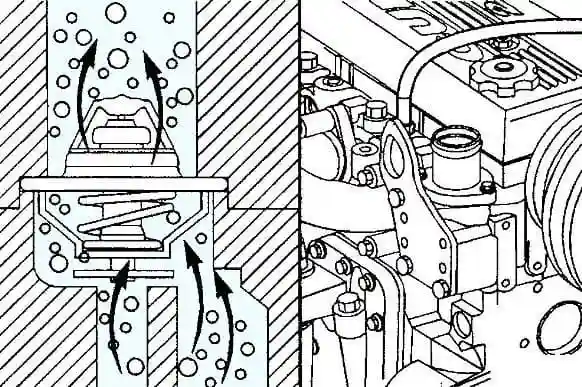
Use an aqueous solution of soda ash, Restore or similar to clean the cooling system.
Used to clean the cooling system of engines operating in severe conditions, Restore removes corrosion products, silica gel and other deposits.
The effectiveness of Restore is dependent on treatment time, temperature, and concentration levels.
Thus, a large amount of scale or partial clogging of the system may require an increase in the concentration of detergent, temperature and time of rinsing, or the use of Restore Plus.
A concentration level of Restore is considered safe if it is no more than 2 times the recommended concentration.
Be sure to use Restore Plus only at the recommended concentration.
If the system is heavily calcified or heavily clogged, it may be necessary to flush the system several times.
- a) Pour cleaning agent into the cooling system.
Caution: Do not install the radiator cap. When performing this operation, the engine must be running without the radiator cap.
- b) Warm up the engine and let it run for 5 minutes with the coolant temperature above 80°C.
- c) Turn off the engine and drain the flushing fluid from the cooling system.
- d) Pour clean water into the cooling system.
Caution: do not install the radiator cap.
Note: Before starting the engine, make sure that the manual air bleed valve installed in the coolant drain circuit of the EGR cooler is closed.
- e) Start the engine and let it run for 5 minutes with the coolant temperature above 80˚C.
- f) Turn off the engine and drain the coolant from the cooling system.
Note: if the drained water is still dirty, be sure to flush the system until it is clear.
Refill coolant.
Attention: it is strictly forbidden to use clean water as a coolant. This can lead to engine damage from corrosion.
To fill the cooling system, use a mixture of equal parts water and antifreeze based on ethylene glycol or propylene glycol.
- a) Fill in the amount of coolant specified in the operating instructions for the vehicle.
Filling capacity approx. 15 l
Recommended coolant:
- - GAZ cars: "Cool Stream Premium", "Shell GlycosheU, Diluted", "ES Сompteat".
- - PAZ buses: "Cool Stream Standart 40", "Fleet Charge 50/50".
- b) Install the filler cap.
- c) Warm up the engine to 80°C and check for coolant leaks.
- d) Check the coolant level again to make sure the system is filled with coolant or has risen to the maximum level in the system expansion tank (if equipped).
Removing water from the fuel pre-filter
Note: regularly drain the water from the fuel filter without waiting for the indicator to turn on.
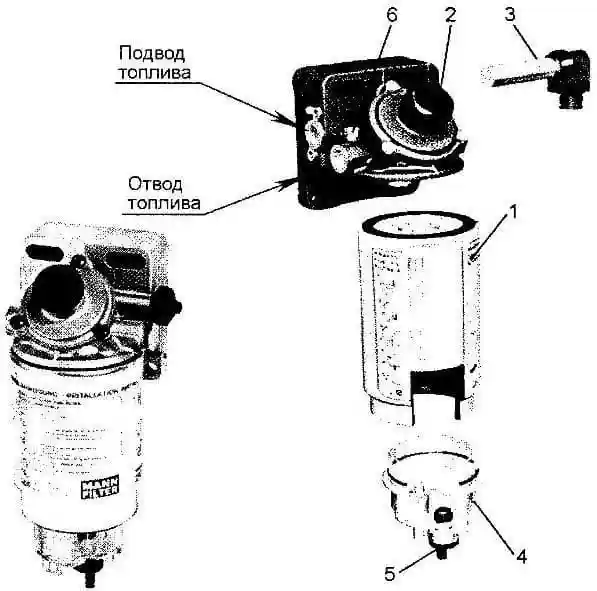
Stop the engine.
Unscrew the plug (5) located at the bottom of the water separator.
Drain the water until fuel appears.
If more than 50 g of fuel is drained, bleed the fuel system using a manual fuel priming pump.
- а) Loosen the plug (6) by 2 - 3 turns.
- b) Bleed the fuel system with the manual priming pump (2) until fuel appears without air bubbles.
- c) Close the plug (6). Tightening torque 6 Nm
Fuel filter
Disconnect the connector from the water sensor.
Loosen and remove the fuel filter.
Make sure the O-ring is not stuck to the fuel filter head.
Remove the O-ring if necessary.
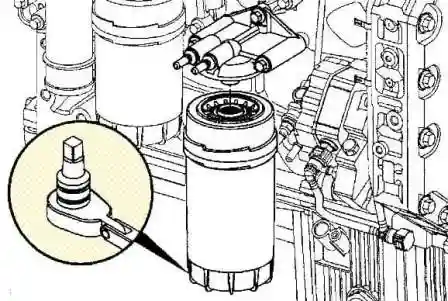
Lubricate the O-ring with clean oil.
Install the fuel filter on the filter cap.
Turn the filter in until it contacts the cap.
Use a puller to tighten the filter 3/4 turn. Tightening torque 23 Nm
Note: Do not prefill the fuel filter with fuel.
Bleed the low pressure fuel system with a hand pump (140 - 150 strokes for a dry filter).
Start the engine.
If the engine does not start within 30 seconds, turn off the ignition.
Operate the priming pump again, repeating the above steps until the engine starts.
If the engine starts, it may run erratically and noisily for the first few minutes, which is not a malfunction.





